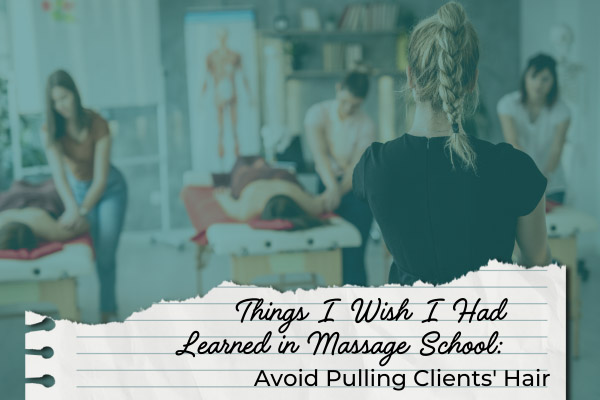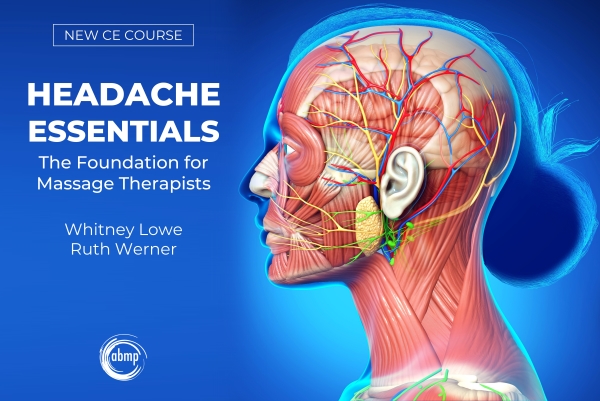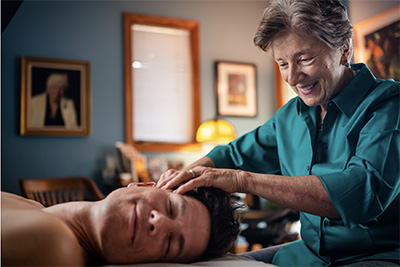
You may read that headline and think this topic can’t possibly apply to you . . . but it does. It’s the finer details that matter in a massage therapy session, and unintentional hair pulling is a detail that carries more weight than you might think. It also happens more than you may realize.
Has this ever happened to you? A client is blissed out while receiving nurturing, soothing, “feel-good” massage strokes when suddenly (and seemingly out of nowhere), the client winces or fidgets. Their eyes might even open slightly for a moment. You either don’t notice it or you think, “What just happened?” You check in. “Is this pressure comfortable for you or would you prefer I lighten up?” The client responds that the pressure is good. So, what’s with the sign of discomfort?
While practitioners are highly attuned to pressure because we are taught in school to do so, an often-overlooked cause of discomfort for our clients is unintended hair pulling. I can say from personal experience, primarily as a massage recipient, that it happens often and is worthy of our attention.
Here are some circumstances when you might inadvertently pull a client’s hair and cause sudden discomfort (which pulls the client out of their happy, blissful place), and tips for how you can avoid it:
1. Supine: Medium and Long-Haired Clients
- Problem: Your client is in supine position, and you are working on their neck. As you apply gliding or kneading strokes to the client’s posterior neck and upper back/shoulders with hands cupped upward, you unintentionally grab a hair and drag it with your stroke.
- Solution: Fix the problem by intentionally getting the hair out of your way before you begin applying strokes. Simply cup the client’s head in one hand and gently lift it while using the other hand to sweep the hair back and superiorly away from the neck. It’s simple! Yet, too often it is not done—trust me, I have experienced this as a receiver more times than I can count.
- Problem: As you apply shorter, focused strokes to the client’s suboccipital region, it seems unavoidable to place your fingertips over their hair. After all, there is hair in this region that can’t be swept out of the way.
- Solution: Fix the problem by sliding your fingertips into the hair with the intention of getting as close to the scalp as possible. This means your fingertips will be at the hair shaft as it exits the scalp rather than over the hair. This will also help you access the tissue directly, which has greater therapeutic effect. This same approach applies to massaging the overall scalp, whether the client is supine or prone. It also offers a secondary benefit of reducing the sound of hair being rubbed over the scalp, which can be distracting for the client.
Prone: Medium and Long-Haired Clients
- Problem: Your client is in prone position, and you are working on their neck and back. As your stroke glides across the skin, some hair (or even a single hair, which is equally uncomfortable) gets caught in the glide.
- Solution: Fix the problem by using a prop to clear the hair completely out of the way of your strokes. One option is a hair clip. Another is to place a towel over the back of the head, then tuck it around and under the sides of the hair. An even more effective approach than a flat towel is to invest in a cloth hair wrap that conforms to the head. Be sure to ask the client if it is OK to slightly mess up their hair. Sometimes this is a no-no for clients who are going somewhere after their massage.
Many therapists sweep the hair out of the way with their hands; however, in prone position it is common that the hair lands back within the line of your strokes. Then, the hair must be continuously moved, which can break your flow and cause distraction. The best way to ensure your path is clear is to secure the hair where you want it and away from where you don’t want it.
A note on hygienic practices: Clips and towels are single-use items only. Purchase several clips to keep on hand and, after each use, soak them in a bowl of warm water with a couple of drops of shampoo. Then, dry them with a towel. And, of course, treat each towel or head wrap as you would a set of sheets and launder after each use.
Clients with Excessive Body Hair
Finally, don’t forget to consider the comfort of your clients who have excessive body hair. This is one of those circumstances when there is nothing you can do to get hair out of your way or avoid working over the hair. However, you can keep from pulling the hair using two great tools: the right lubricant and the right focus.
First, choose your lubricant wisely. This is something you will want to experiment with depending on the type of work you do. What has worked best for me is to use a massage cream. Lotions tend to absorb too quickly, and oils are too greasy for my personal preference (and for clients who don’t want to leave feeling like they are covered in oil). Creams are great because they last through more strokes and don’t have to be applied as often, yet they absorb well enough to not leave the client feeling excessive residue on their skin. And, amazingly enough, they allow for gliding over the hair without pulling on it.
Second, as you apply strokes over a hairy arm, leg, or back, if you focus on your contact with the skin and underlying tissue, you naturally go beyond the hair even if you are gliding over it. It’s a phenomenon I can’t entirely explain, yet I can attest to how well it works.
What I Wish I Learned
Massage school can’t teach us everything we might encounter in our practices, but this is one detail you don’t want to miss. Even if you think you never pull a client’s hair, I can guarantee that sometimes you do (unless, of course, you have already incorporated these practices). Taking simple steps to overcome a small, but significant, occurrence can bring the bliss back to the entirety of your sessions!
author bio
Since 2000, Cindy Williams, LMT, has been actively involved in the massage profession as a practitioner, school administrator, instructor, curriculum developer, and mentor. In addition to maintaining a part-time massage and bodywork practice and teaching yoga, she is a freelance content writer and educational consultant. Contact her at massagetherapyfortwayne@gmail.com.


